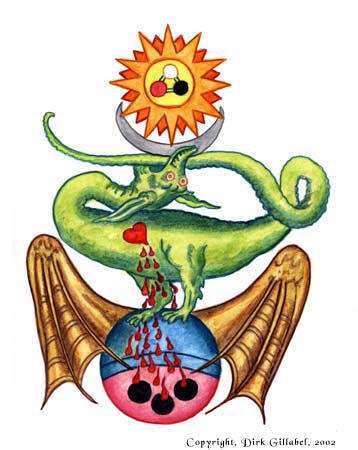|
Introduction
Alchemy has always had a bad reputation, but at the
same time it also has had an irresistible attraction. Many people have gotten
involved in alchemy, each in their own way, with their own practice. For
some it was a spiritual quest, others were looking to make gold and get
rich, some made chemical discoveries, and others were philosophers. Alchemy
has been, and continues to be, a stimulus for many people to seek, to wonder,
to philosophize, and to learn more about what Nature has to offer us. It
is a universal way of discovery and we find it in many cultures.
In its
origins and and in its essence, alchemy is spiritual. The search for the
alchemical gold is the search for wisdom, light, perfection, and enlightenment.
In past times there was no separation between science and religion/spirituality,
and thus we find alchemy mixed with other areas of 'science'. In Western
Europe, alchemy used many symbols from chemical science, probably to disguise
their actions during times of persecution by the Catholic Church. But it
also allowed them to use a language to express spiritual experiences for
which there was no vocabulary.
Over time many people, misunderstanding
its essence, got involved in their own 'alchemy', only looking to make physical
gold. Some were indeed charlatans and the reputation of alchemy became clouded.
When reading numerous alchemical texts, one easily gets lost in the manifold
symbols, contradictions, claims, processes, and so on. It is obvious that
each writer, for as far as he was honest, had their own interpretation of
what alchemy was, or what the symbols meant. Some alchemists made their
texts intentionally confusing, so only an experienced colleague knew what
the writing was about. But other writers were very clear, and with almost
no obscure symbolic language wrote about their experiences. From those writings
it is obvious that alchemy is about the discovery of the spiritual nature
of man, of nature and of the cosmos, and especially about one's own development.

There were alchemists who used alchemical symbols for their chemical
work, therefore one has to know if a text is philosophical or purely chemical.
To find out read his text and see what the symbols he was using meant. Remember,
however, there is a basic common language, as I have tried to explain this
in this article. Keep in mind that any symbol can be approached from many
sides and can have a number of interpretations. It is more important the
you get a 'sense' of what it is all about, than it is to fixate yourself
on the meanings of particular symbols.
The central idea in alchemy is
that matter and spirit are one whole unity. They are inseparable and one
works on the other. "With the aid and help of God, she (alchemy) reveals
all hidden energies of the whole wide world. As the vine grower grafts the
vine to the elm and espalier, thus the magician, the alchemist, marries
and unifies heaven and earth, the lower and the higher energies." (Pic
de Mirandole).
The alchemist must purify himself in this material-spiritual
world. Alchemy was an art that was more refined than any other art or science,
because alchemical transmutation demanded more than skill and knowledge.
Spiritual qualities were necessary. Only when one had attained the highest
state of perfection one could make the philosopher's stone. Therefore one
must unify himself with the divine, resulting in a new 'birth' or new state
of consciousness.
Franciscus Kieser (16-17th century) explained that
there is Wisdom, a light that is the breath of the divine energy. This Wisdom
is a ray, a brilliance, a mirror, and is the manifestation of the divine
energies. It moves everything. it rules over and emanates Nature; it is
invisible and a maintaining fire, an inscrutable power of the uncreated
interior. When it leaves the creations it immediately goes to the grace
of God, to the Holy Spirit. This is what the true alchemists were after.
It is found both outside and inside oneself.
|

